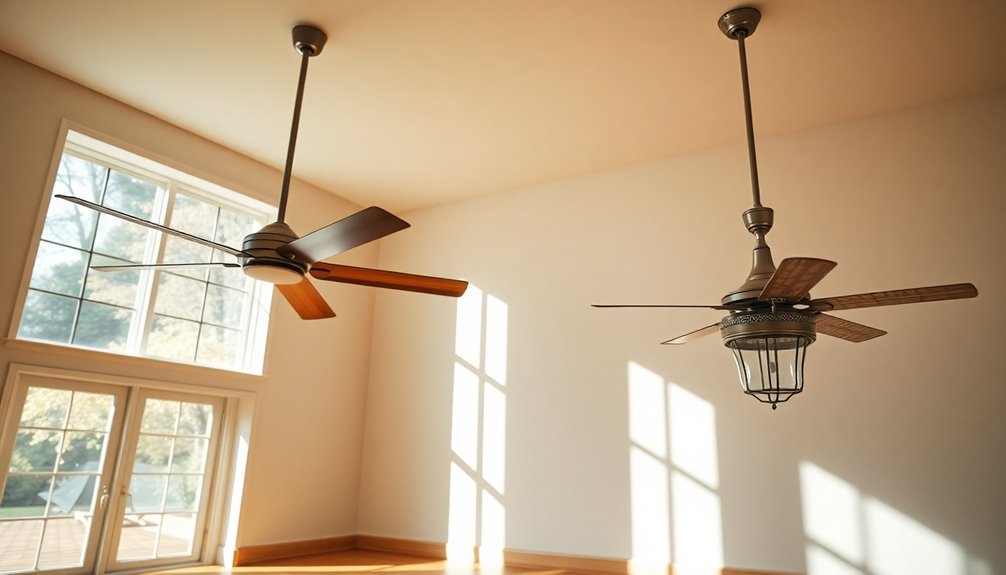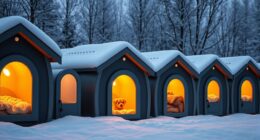Using two ceiling fans in one room boosts both style and functionality. Choose fans that complement your decor while being the right size for your space—aim for 36-44 inches in smaller rooms and 52 inches in larger ones. Make sure there's at least 50 inches between them for ideal airflow and maintain a minimum ceiling height of 8 feet for safety. Don't forget to regularly clean and maintain your fans to keep them running smoothly. With the right tips, you can maximize comfort and aesthetics. If you're curious about more expert advice, there's much more to explore on this topic.
Key Takeaways
- Choose two fans with a complementary design to enhance the room's aesthetic while maintaining visual harmony.
- Ensure fans are spaced at least 50 inches apart for optimal airflow and to prevent collisions.
- Select fans with directional control to customize airflow for different seating areas in the room.
- Opt for energy-efficient models to reduce utility costs and promote sustainable living.
- Regularly clean and maintain both fans to ensure consistent performance and longevity.
Ceiling Fan Sizing

When choosing a ceiling fan, it's crucial to take into account the room size, as the right fan can greatly enhance your comfort.
For smaller rooms up to 225 square feet, a fan sized between 36 to 44 inches works best for cooling and airflow. If you're dealing with larger areas, opt for a 52-inch fan to guarantee ideal air circulation.
Remember, incorrectly sized ceiling fans can lead to inefficient cooling, so measure your room dimensions before installation.
If you're thinking about two fans in large living or dining areas, maintain at least 50 inches of spacing between them to promote effective airflow and prevent obstructions.
Proper sizing and spacing make all the difference in your comfort and enjoyment.
Installation Guidelines

Choosing the right ceiling fan is just the beginning; proper installation is key to maximizing its effectiveness.
First, confirm your ceiling height is at least eight feet. This allows for safe installation of two fans without obstruction. Maintain a minimum of 50 inches of clearance between the fans for ideal airflow and to prevent interference.
Position fan blades at least 18 inches away from walls to enhance air circulation. Carefully calculate the spacing between the fans and surrounding fixtures to avoid any obstructions.
Finally, verify that the mounting hardware is securely installed and can support the weight and operation of both fans. Following these guidelines will guarantee you enjoy efficient cooling and comfort in your space.
Maintenance and Care

Regular maintenance is essential for keeping your ceiling fans running efficiently and extending their lifespan.
Start with regular cleaning of the fan blades to prevent dust buildup that can hinder performance.
Inspect electrical connections periodically to catch any potential faults early, guaranteeing both functionality and safety.
When components like blades or motors show signs of wear, replace them promptly to maintain peak efficiency.
Develop a maintenance strategy that includes seasonal checks, such as reversing blade direction in winter for better heating.
Finally, guarantee easy access to your fans for routine maintenance tasks, making it simpler to keep them operating safely and effectively. Additionally, addressing any unusual sounds, such as a clicking noise, can prevent potential safety hazards.
Troubleshooting Issues

If your ceiling fans aren't performing as expected, it's time to troubleshoot some common issues.
Start by checking for obstructions, inspecting electrical connections, and ensuring the settings are correct.
Regular maintenance can make a big difference in how well your fans operate and extend their lifespan.
Common Fan Problems
When your ceiling fan starts to act up, it can be frustrating, especially if you rely on it for comfort. Slow fan speed often points to mechanical issues or the need for lubrication, so inspect the fan's components for wear or obstruction.
Regularly cleaning the fan blades is essential; dirt buildup can hinder performance and drastically reduce airflow efficiency. If you notice inconsistent operation, check the electrical connections—loose or faulty wires can cause trouble.
Additionally, make sure that your fan settings are adjusted for the desired airflow direction, especially in rooms with two fans. Proper use can create a more pleasant living environment, especially when considering energy savings from efficient ceiling fans.
Finally, troubleshooting should include verifying the compatibility of your fans with existing electrical systems to avoid potential malfunctions or safety hazards.
Maintenance and Solutions
To keep your ceiling fan running smoothly, routine maintenance is crucial. Start by regularly cleaning the fan blades to remove dust and debris, as this considerably enhances performance and prevents slow speeds caused by obstructions.
Periodically inspect electrical connections to verify they're secure and free from corrosion; faulty connections can lead to inconsistent fan operation. If your fans are running slowly, double-check the settings to confirm they're set to the desired speed, as incorrect settings can hinder airflow.
Address any mechanical issues, like worn bearings, by replacing or servicing them for ideal functionality.
Finally, regular maintenance, including checking for loose screws and verifying proper balance, can prevent wobbling and noise, contributing to a quieter, more efficient fan operation.
Safety Considerations

Guaranteeing the safety of ceiling fans in your room is essential, as improper installation or maintenance can lead to accidents.
Start by securing the mounting hardware during installation, making certain it meets safety standards. Position your fans at least 18 inches away from walls to allow for proper airflow and minimize obstruction hazards.
Maintaining a minimum ceiling height of eight feet is critical for safe operation, preventing the fans from hanging too low. Regular inspections are important; check for loose components or wear on the blades to enhance safety.
Finally, make sure there's adequate spacing of 50 inches between the two fans to optimize airflow and reduce the risk of collisions or interference.
Prioritize these safety considerations for a worry-free environment.
Design Choices

When choosing ceiling fans, coordinating styles and finishes can really enhance your room's aesthetics.
Think about pairing a brushed nickel fan with a sleek white one for a chic look.
Also, consider their placement to achieve symmetry, creating a balanced visual appeal that ties everything together. Additionally, utilizing vertical space utilization in your design choices can further improve the functionality and aesthetic of the room.
Coordinating Styles and Finishes
How can you create a harmonious atmosphere in a room with two ceiling fans? Start by choosing coordinating finishes like brushed nickel or oil-rubbed bronze to achieve a cohesive look.
Here are some tips to take into account:
- Opt for a uniform style across both fans to enhance thematic consistency.
- If you prefer contrasting designs, make certain they still complement each other for visual interest.
- Pay attention to room dimensions; larger spaces benefit from two 52-inch fans for ideal airflow.
- Select similar blade materials, such as wood or metal, to maintain a harmonious aesthetic.
Utilizing visual tools, like room settings viewers, can help you visualize how different styles and finishes will work together in your space before making a purchase. Additionally, consider the energy efficiency ratings of the fans to ensure they contribute to lower electricity bills while enhancing comfort.
Enhancing Room Aesthetics
Choosing the right design elements can markedly enhance the aesthetics of a room with two ceiling fans. Opt for ceiling fans with complementary designs to create a cohesive look that elevates your decor.
Matching finishes, like brushed nickel or oil-rubbed bronze, add elegance and uniformity. When placing the fans, consider the room layout and color scheme to guarantee they blend seamlessly with existing decor.
Utilizing fans of the same style but varying sizes introduces visual interest while maintaining a consistent design theme.
Don't forget to incorporate unique features, such as LED lighting or decorative blades; these elements not only enhance room aesthetics but also serve practical purposes, tying the overall design together beautifully. Additionally, consider using sustainable materials for your ceiling fans, as they contribute to a healthier home environment while adding a touch of modern elegance.
Functional Benefits

Installing two ceiling fans in a room can transform your space by greatly enhancing airflow and guaranteeing even cooling.
With dual fans, you'll experience several functional benefits:
- Improved Airflow: Dual fans eliminate hot spots and guarantee consistent temperature throughout larger spaces.
- Directional Airflow Control: You can customize airflow for specific seating areas, maximizing comfort.
- Enhanced Energy Efficiency: By reducing reliance on air conditioning, you'll enjoy lower utility bills while promoting better air circulation.
- Aesthetic Symmetry: Two ceiling fans create a balanced look, enhancing the visual appeal of your room.
This flexibility in operation allows you to control both fans independently or together, optimizing cooling effectiveness for your comfort.
Popular Trends

Ceiling fans are embracing a wave of popular trends that cater to modern lifestyles and aesthetic preferences. Smart ceiling fans are leading the charge, providing remote control and automation features for enhanced functionality and energy efficiency. Vintage designs are making a comeback, appealing to your nostalgic side while adding character to your spaces. Energy Star-rated fans are also in high demand, ensuring sustainability and energy savings. Additionally, the integration of LED lighting in fan designs offers dual functionality, eliminating the need for separate fixtures. Customizable options are on the rise, allowing you to tailor your ceiling fans to match your unique style.
| Trend | Description |
|---|---|
| Smart Ceiling Fans | Remote control and automation features |
| Vintage Designs | Nostalgic aesthetics for modern spaces |
| Energy Star-rated | Eco-friendly and energy-efficient options |
| LED Lighting | Integrated lighting reduces fixture needs |
Frequently Asked Questions
Is It Okay to Have Two Ceiling Fans in One Room?
Yes, it's perfectly okay to have two ceiling fans in one room!
In fact, if you've got a larger or long-shaped space, two fans can help distribute air evenly and improve airflow efficiency.
Just make sure to space them appropriately, keeping them 2-4 feet apart and at least 18 inches from walls.
This setup not only enhances comfort but also simplifies installation, making it a smart choice for your home.
How to Cool Your Room With Two Fans?
To cool your room with two fans, start by positioning them strategically for ideal airflow.
Place them at least 2 to 4 feet apart and 18 inches from the walls. This setup allows the fans to work together, creating a more even temperature across the space.
Adjust the direction of each fan to target specific areas where you need cooling most.
Don't forget to regularly clean them for maximum efficiency!
What Is the Rule of Thumb for Ceiling Fans?
Ever wondered how to pick the perfect ceiling fan? The rule of thumb is simple: if your room's up to 225 sq ft, go for a 36 to 44-inch fan.
For larger spaces, a 52-inch fan works best. Remember to keep blades at least 18 inches from walls for proper airflow.
And don't forget, you need at least eight feet of ceiling height for safe installation. Regular maintenance will help keep your fan running smoothly!
How Far Apart Should Two Ceiling Fans Be?
When you're installing two ceiling fans, they should be spaced at least 50 inches apart to guarantee ideal airflow. This distance prevents interference between the fans, allowing them to operate efficiently.
Additionally, maintain a distance of 2-4 feet from walls or other obstacles for better air circulation and safety.
If your room is larger or long-shaped, consider aligning the fans with the room's layout for even air distribution.
Conclusion
Incorporating two ceiling fans in one room can create a dance of cool air and style, like a gentle breeze swaying through your favorite summer meadow. With careful consideration of size, design, and maintenance, you'll not only enhance your space's aesthetic but also guarantee comfort and efficiency. Embrace the harmony of functionality and beauty, and let your room become a sanctuary where both form and function flourish, inviting you to unwind and enjoy the moment.









